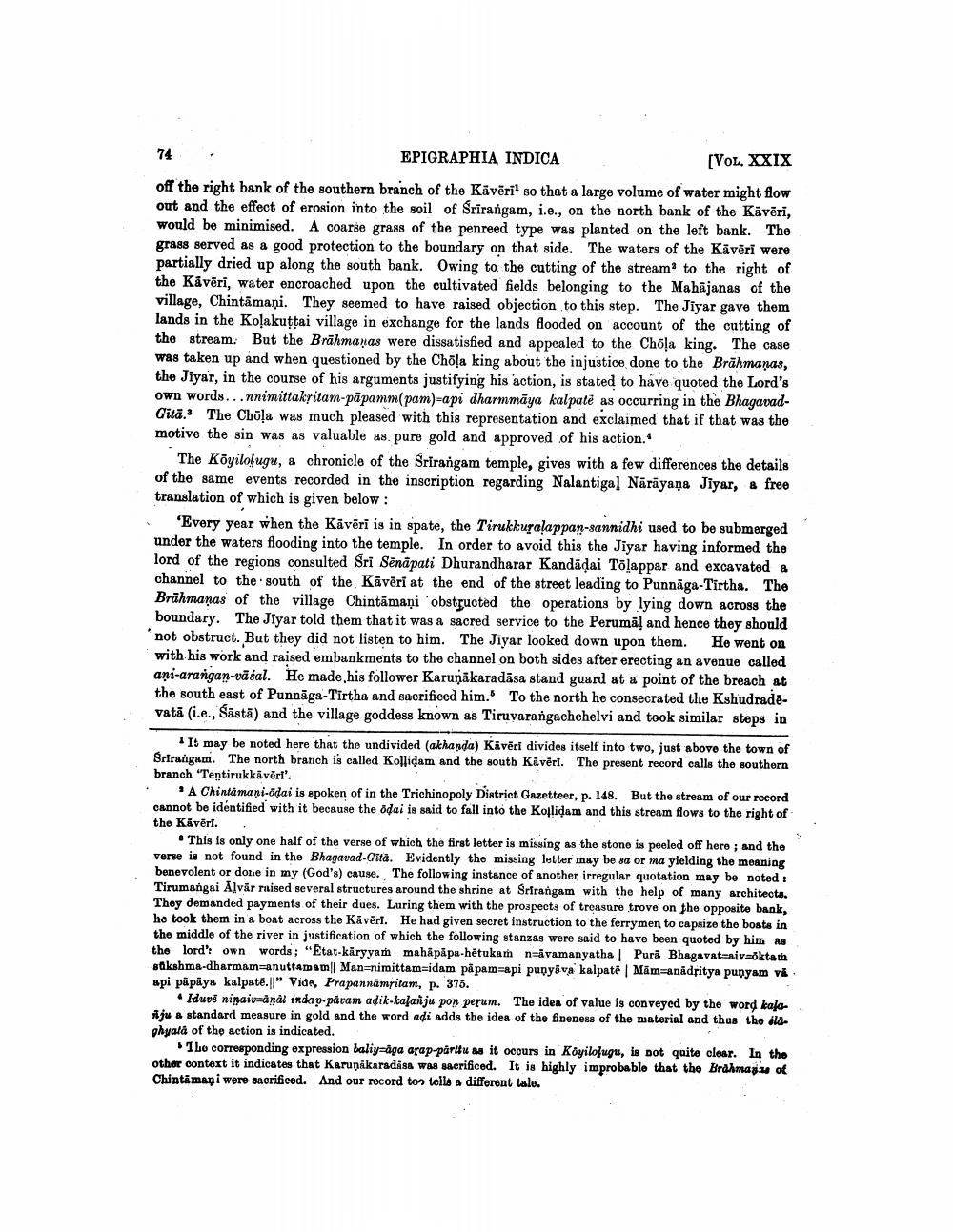________________
EPIGRAPHIA INDICA
(VOL. XXIX off the right bank of the southern branch of the Kāvērit so that a large volume of water might flow out and the effect of erosion into the soil of Srirangam, i.e., on the north bank of the Kävēri, would be minimised. A coarse grass of the penreed type was planted on the left bank. The grass served as a good protection to the boundary on that side. The waters of the Kävēri were partially dried up along the south bank. Owing to the cutting of the stream to the right of the Kávēri, water encroached upon the cultivated fields belonging to the Mahājanas of the village, Chintamani. They seemed to have raised objection to this step. The Jiyar gave them lands in the Kolakuttai village in exchange for the lands flooded on account of the cutting of the stream. But the Brāhmaṇas were dissatisfied and appealed to the Chöļa king. The case was taken up and when questioned by the Chola king about the injustice done to the Brāhmaṇas, the Jiyar, in the course of his arguments justifying his action, is stated to have quoted the Lord's own words... nnimittakritam-pāpamm(pam)-api dharmmāya kalpaté as occurring in the BhagavadGita. The Chola was much pleased with this representation and exclaimed that if that was the motive the sin was as valuable as pure gold and approved of his action.
The Köyilolugu, & chronicle of the Srirangam temple, gives with a few differences the details of the same events recorded in the inscription regarding Nalantiga) Nārāyana Jiyar, a free translation of which is given below:
'Every year when the Kävēri is in spate, the Tirukkuralappan-sannidhi used to be submerged under the waters flooding into the temple. In order to avoid this the Jiyar having informed the lord of the regions consulted Sri Sēnāpati Dhurandharar Kandādai Tölappar and excavated & channel to the south of the Kāvēri at the end of the street leading to Punnāga-Tirtha. The Brāhmanas of the village Chintamani 'obstructed the operations by lying down across the boundary. The Jiyar told them that it was a sacred service to the Perumāļ and hence they should not obstruct. But they did not listen to him. The Jiyar looked down upon them. He went on with his work and raised embankments to the channel on both sides after erecting an avenue called ani-arangan-vāśal. He made his follower Karunakaradāsa stand guard at a point of the breach at the south east of Punnāga-Tirtha and sacrificed him. To the north he consecrated the Kshudradevatā (i.e., Sāstā) and the village goddess known as Tiruvarangachchelvi and took similar steps in
It may be noted here that the undivided (akhanda) Kávēri divides itself into two, just above the town of Srirangam. The north branch is called Kollidam and the south Kivért. The present record calls the southern branch 'Tentirukkāvērt'.
A Chintamani-odai is spoken of in the Trichinopoly District Gazetteer, p. 148. But the stream of our record cannot be identified with it because the odai is said to fall into the Koflidam and this stream flows to the right of the Kávēri. .
* This is only one half of the verse of which the first letter is missing as the stone is peeled off hero ; and the verse is not found in the Bhagavad-Gita. Evidently the missing letter may be sa or ma yielding the meaning benevolent or done in my (God's) cause. The following instance of another irregular quotation may be noted : Tirumangai Alvår raised several structures around the shrine at Srirangam with the help of many architects. They demanded payments of their dues. Luring them with the prospects of treasure trove on the opposite bank, ho took them in a boat across the Kävērl. He had given secret instruction to the ferrymen to capsize the boats in the middle of the river in justification of which the following stanzas were said to have been quoted by him as the lord': own words; "Etat-käryyam mahāpāpa-hētukam nzivamanyatha | Pura Bhagavat aivaoktat sakshma-dharmam=anuttamam|| Man=nimittam=idam pāpam-api punyava kalpaté Mām=anāditya punyam vi api pāpāya kalpaté.I" Vide, Prapannāmsitam, p. 375.
• Idupe ninaiv=anal in day param adik-kajanju pon perum. The idea of value is conveyed by the word kala lju & standard measure in gold and the word adi adds the idea of the fineness of the material and thus the dla. ghyata of the action is indicated.
I Lo corresponding expression baliyaga arap-parttu as it occurs in Köyilolugu, is not quite clear. In the other context it indicates that Karuņikaradasa was sacrificed. It is highly improbable that the Brahmans of Chintamapi were sacrificed. And our record to tells a different talo.




